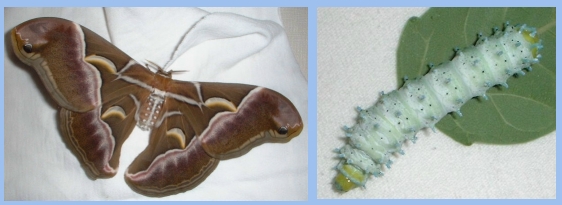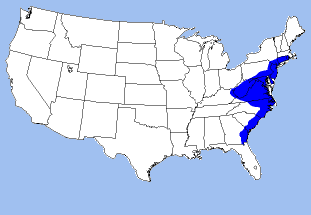

NOTICE: Available now is a book giving a detailed revision of the genus Samia. If interested in purchasing this book, please visit this website for information! http://www.uiw.edu/biology/book.html
Descriptive Qualities:
Range
Map of this moth's Area:

Eggs and Larva
Depending on the particular size of the moth, approximately 150 - 300 eggs. Cynthia larva look much like Promethea larva when they first hatch. They are yellow with black tuberacles, that make them appear to have stripes. They look the same for second instar, but being bigger makes their tuberacles more visible, so the illusion of stripes is lost. In third and fourth instar, they are white with white tuberacles. They have a white powder completely covering their body, except their head, which is yellow. In fifth instar, they tend to lose much of their powder, and they have a blueish tint to them.
Scenting and Mating
Female Cynthia moths usually put their scent out between midnight and 3:00 AM. Males may come in at
any time during that period. It is easiest to put the female in a metal cage with holes big
enough that they can mate through it (about a half inch or 3/4 inch hole should do nicely) but
small enough that the female cannot escape. That is one way to do it, but I usually stay up and
wait for the males to come in, and then put them with the female. This way is the only real way
to tell how many came in.
Cocoons
Cynthias make very strong cocoons that usually hang on the branch of the trees they are feeding on, however, sometimes they make them incorrectly fastened and the cocoon falls with the leaves. Cynthia cocoons are very similar to that of a Promethea.
Personal Markings or Characteristics
Cynthia moths have pink stripes going down each wing. They have white/yellow crescents on all four wings.
Caring For Cynthias, In All Stages:
Here are some notes that may be helpful when trying to raise Cynthia larva, especially if it's your first time raising them.Caring for the eggs
To care for Cynthia eggs, just put them in a small container. It is best to be small, because the caterpillars like to crawl a lot when they first hatch, and if you put them in a bigger container, they will crawl away from the food you put in with them, and might not be able to get back. That's a lot of area for such a small caterpillar.
Food Plants
Here is a list of all food plants that I have ever used to raise Cynthias on. In the odd occurance that you can not come by any of these, you should contact me.
Click here for extra information on a very closely related species: Cynthia-Recini
Raising the Larva (Inside)
Cynthia larva are pretty easy to raise. As long as you are feeding them on Ailanthus. They are fairly tolerant of crowding, but should not be overcrowed or they may get disease and die.
Raising the Larva (Outside)
Cynthia larva are easy to raise outside. You just find a suitable host plant and put the larva on it. It is best to put them on a branch and then put the branch inside some sort of netting, so that they are protected from predators like insects, birds, and rodents.
Caring for the cocoons
Caring for the cocoons is pretty simple. You should put them in an area where it is fairly moist, if the cocoons dry out, they will die. If you just put them outside they should be fine. You cannot leave them inside, because they will hatch, but you can keep them in the refridgerator. If you do this, it is best to spray the cocoons with a light mist every once in a while so they don't dry out.
Click here to return to the Index